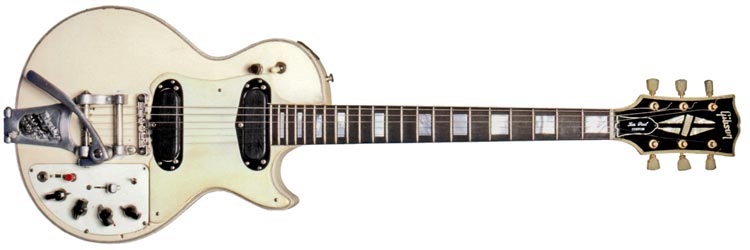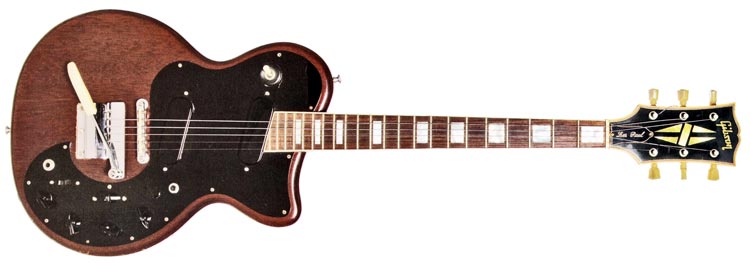

Les Paul was a superb guitarist, engineer and inventor - and despite being given dozens of guitars by Gibson, he rarely left them alone, modifying the controls, experimenting with new pickup designs and generally attempting to improve their usability. As a guitarist and vocalist, he usually built a microphone into the guitar, allowing him to perform without a microphone stand. In many ways, the Les Paul Personal was the culmination of the man's experiments in recording electric guitars in the 1950s and throughout the 1960s.
The Les Paul Personal was closely related to the Les Paul Professional guitar and Les Paul bass. It was first listed in the September 1969 Gibson price list, along with the above models; all low-impedance instruments in a dark walnut finish. The Les Paul Personal was the top of the range; priced at $645, it was even more expensive than the Les Paul Custom, at $575.
It only appeared in one Gibson catalogue, the 1970 Les Paul brochure (see below) before production fizzled out into the early 1970s.

The Les Paul Personal has gold hardware throughout. Note the extra control pot on the top bout, next to the pickup selector switch. This controls the microphone volume. The microphone XLR jack is visible on the top edge, just above this control.
The main difference between the Les Paul Personal and the Les Paul Professional was the addition of the vocal microphone (with it's own volume control) that extended from the top of the guitar. It was also more ornate, with the Gibson split diamond headstock inlays, an ebony fretboard and gold-plated hardware throughout. The guitars themselves were electronically identical.
Les Paul a great guitarist, but it was his inventive engineering skills that lead to the experimental circuitry that was the core of the low impedance Les Paul range. Electronically this was a very clever instrument, providing far greater degree of control to the tone produced by the instrument than on any other guitar at the time.
There is a detailed explanation of all the controls in the 1969 Les Paul Personal / Professional owners manual. Attention must be paid to these as the controls do not necessarily act as might be expected - especially with regard the tone switch.
Intuitively, one would think that a tone switch would 'change' the tone produced. But what it actually does is to bypass sections of the controls, including pickup selector. This is rather clever, allowing a musician to switch from a wide open sound using both pickups, to a lead sound maybe just using the bridge, with the treble setting all the way up and the bass backed off a little - using just one switch. The table below shows which controls are active (checked) and which are bypassed for each tone position.
| tone control position | |||
| 1 | 2 | 3 | |
| treble | ✓ | ||
| bass | ✓ | ||
| decade | ✓ | ✓ | |
| pickup selector | both | ✓ | ✓ |
| phase switch | ✓ | ✓ | |
Les Paul had hundreds of guitars and dozens of them were modified with experimental pickups and circuitry. The guitar below is a late 1950s Les Paul Custom, with low impedance pickups and substantially similar controls, including microphone jack on the top edge. He produced numerous variations of this guitar, but as can be seen, they are not at all far from the final design chosen by Gibson in 1969.

The guitar pictured below was a prototype for the new low impedance guitar models, most likely from 1968. The body design is interesting - it's slanted edge (replacing cutaways) runs parallel with the neck pickup and fretboard edge - certainly original. But by late '68 the Les Paul Standard and Custom had undergone a very successful reissue, perhaps swaying the decision towards the classic single cutaway body style.

The above two guitars were part of an auction of Les Paul's guitars in 2012 by Juliens auctions.
The Les Paul Personal was produced in very small numbers between 1969 and 1973 at Gibson's Kalamazoo plant, MI, with a total of 370 guitars shipped. The peak year was 1970 with 220 guitars. Figures according to Gibson Shipment Totals by Larry Meiners
| 1969 | 1970 | 1971 | 1972 | 1973 | total |
|---|---|---|---|---|---|
| 2 | 222 | 95 | 49 | 2 | 370 |
$4695
$5500
$2350
$2919
$4495
£102
€3750